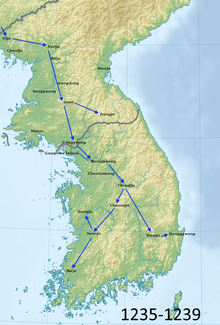
Back الغزوات المغولية لكوريا Arabic Mongoleninvasionen in Korea German Invasiones mongolas de Corea Spanish حمله مغول به کره Persian Mongolien hyökkäykset Koreaan Finnish Invasions mongoles de la Corée French Invasi Korea oleh Mongol ID Invasioni mongole della Corea Italian モンゴルの高麗侵攻 Japanese 고려-몽골 전쟁 Korean
This article needs additional citations for verification. (April 2022) |
| Mongol invasions of Korea | |||||||
|---|---|---|---|---|---|---|---|
| Part of Mongol invasions and conquests | |||||||
 1235 Mongol invasion of Goryeo | |||||||
| |||||||
| Belligerents | |||||||
|
| Mongol Empire | ||||||
| Commanders and leaders | |||||||
|
Ch'oe U Pak Seo Kim Yun-hu Lý Long Tường Kim Gyeong-son Choi Chunmyeong Dae Jipseong Lee Jaseong Chae Song-nyeon Kim Yun-hu Lee Sehwa Hyeon-Ryeo |
Ögedei Khan Möngke Khan Subutai Danqu Putau Yegü Teke Qorči Saritai † Jalairtai | ||||||

A series of campaigns were conducted between 1231 and 1270 by the Mongol Empire against the Goryeo dynasty of Korea. There were seven major campaigns at tremendous cost to civilian lives, the last campaign made most of Goryeo[1] a vassal state[2] of the Yuan dynasty for approximately 80 years. However, rebellion movements existed throughout this time and in 1274, some Goryeo territory existed outside of Mongol control.[1]
The Yuan dynasty would exact wealth and tributes from the Goryeo kings. Despite submission to the Yuan dynasty, internal struggles among Goryeo royalty and rebellions against Yuan rule would continue, the most famous being the Sambyeolcho Rebellion. A greater amount of "stubborn resistance" was put up by Korea and Song Dynasty towards the Mongol invasions than many others in Eurasia who were swiftly crushed by the Mongols at a lightning pace.[3]
- ^ a b An Illustrated Guide to Samurai History and Culture: From the Age of Musashi to Contemporary Pop Culture. North Clarendon, Vermont: Tuttle Publishing. 2022. p. 11. ISBN 978-4-8053-1659-7.
- ^ Henthorn 1963.
- ^ van Derven, H. J. (1 January 2000). Warfare in Chinese History. BRILL. pp. 222–. ISBN 90-04-11774-1.